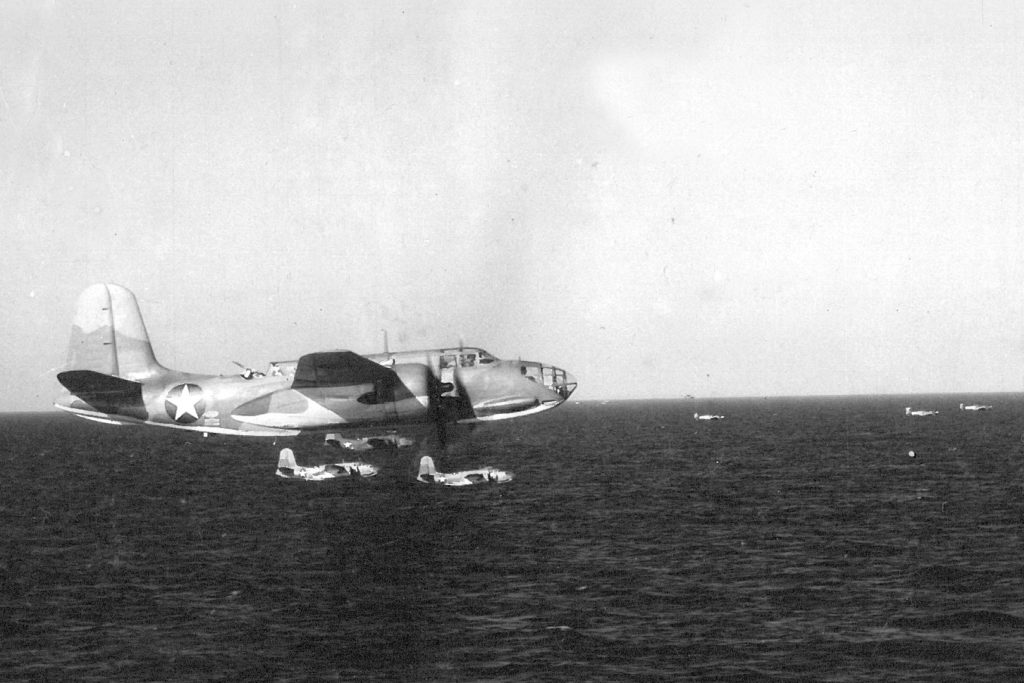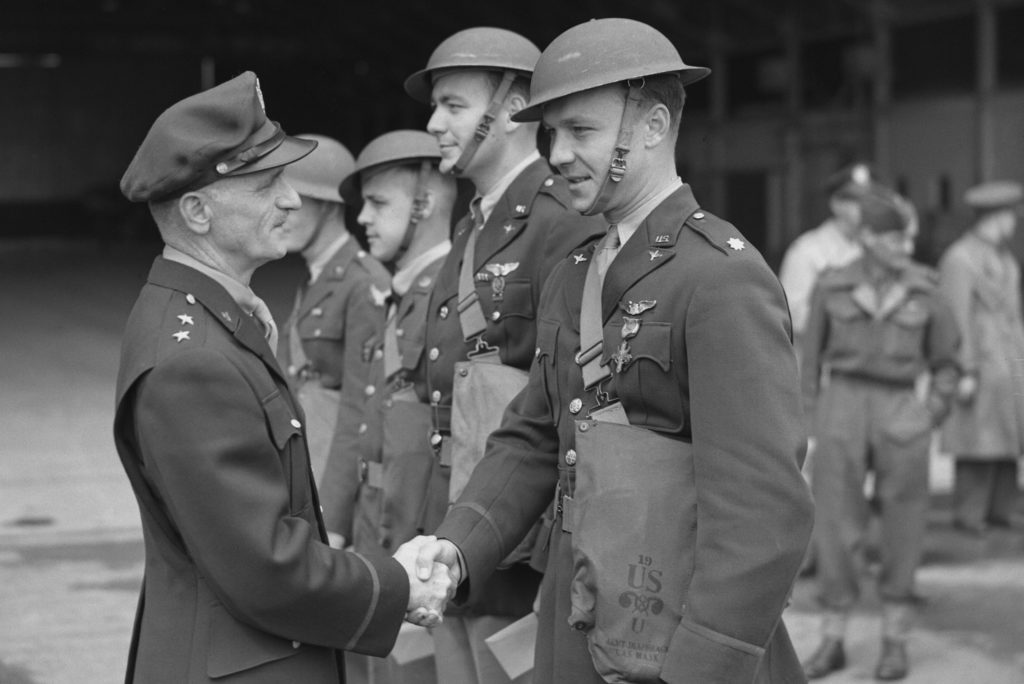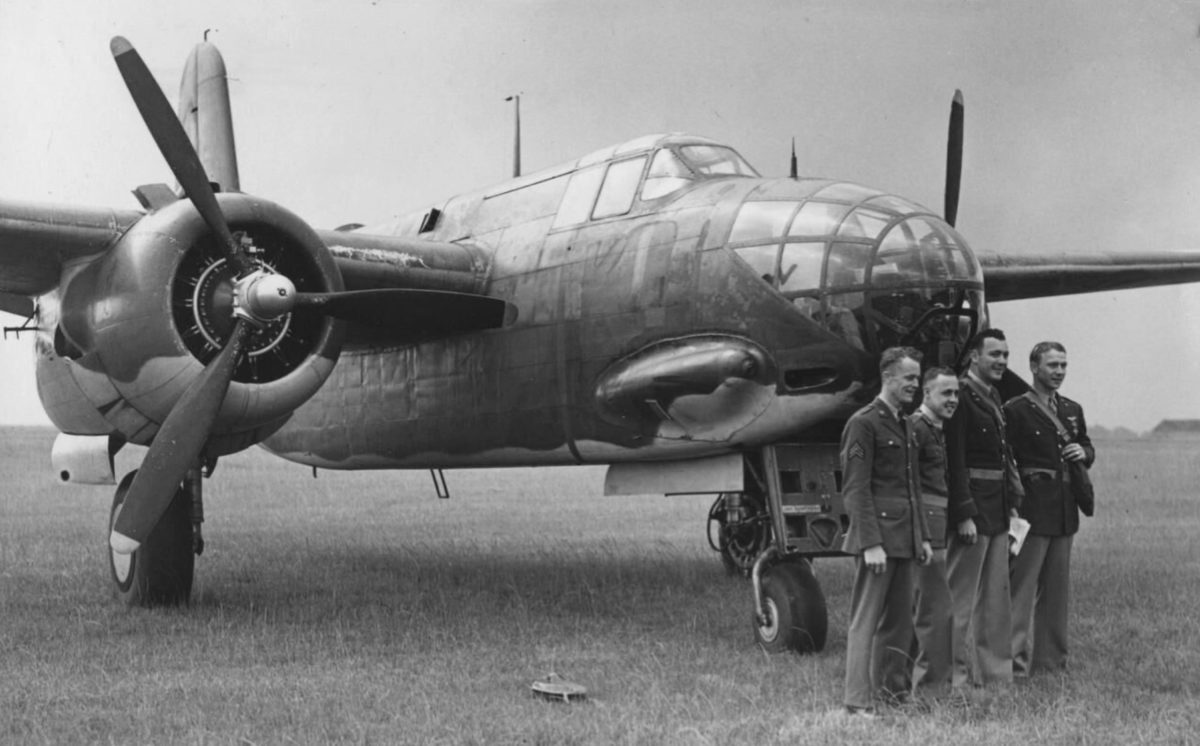In May of 1942, US General Hap Arnold promised Prime Minister Winston Churchill that American troops would be fighting with the British by July 4th. Fulfilling that promise fell to US Generals Carl Spatz, Ira Eaker and Dwight Eisenhower. Yet only two US outfits were in England – the 97th Bombardment Group and the 15th Bombardment Squadron (Light) – and neither was equipped with aircraft. The 15th‘s familiarity with Douglas A-20 Havocs and the presence of the same aircraft in British service, the DB-7 Boston III, secured them a place in Eighth Air Force history. Seven months earlier, members of the 15th had been dropping flour sack bombs on “enemy” troops as part the 1941 Louisiana Maneuvers. Now, a month of training in British bombing methods was the plan to get the Eighth Air Force in the war with its first official combat mission.
The Mission
The mission briefing was given at 1800 hours on July 3rd at Swanton Morley, the home of RAF 226 Squadron. Twelve Douglas Boston DB-7 Boston III aircraft manned by six seasoned British crews and six newly trained American crews were to attack four German fighter bases in occupied Holland. Each of the targets was home to a combination of several squadrons of Bf-109’s, Fw-190’s and Bf-110’s. According to an RAF Intelligence Flight Lieutenant, speed, surprise and dawn darkness would be the keys to their success and survival.
At 0515, in the mist filled darkness of July 4th, the crews waited in their aircraft for the green “go” flare. They had surrendered all identification (except dog tags), picked up escape kits, and donned yellow RAF Mae West life vests. They carried the following bomb loads:
LEAD AIRCRAFT: 2 x 500 lb. GP fused time delay of 11 seconds; 1 x 500 lb. GP fused time delay 30 minutes
AIRCRAFT NOS. TWO and THREE: 2 x 500 lb. GP fused time delay of 11 seconds; 2 Small Bomb Containers (SBC’s) of 8 x 30 pound incendiary
Just when the crews thought the mission might be scrubbed, a green flare shot out from the control tower. At 0700 hours the morning darkness was long gone. The commander of the 15th Bomb Squadron, Captain Charles Kegelman, was a skilled and trusted pilot revered by the US aircrews. He toggled open his mic to reassure his men.
“Not to worry boys. I do all my bombing in broad daylight.”
And indeed he did. On a sunny afternoon on June 29th, 1942, Captain Kegelman had piloted one of twelve RAF DB-7’s to bomb the Hazebroucke marshalling yards in Lille, Northern France. His was the first USAAC crew to bomb occupied Europe.

The flight of twelve aircraft broke formation over the North Sea into four vics of three at a point where each vic would reach its target simultaneously. A German fishing smack acting as a seaborne outpost radioed the alarm to German flak defenses.
As the low flying raiders swept inland, barely clearing the thick rolls of barbed wire that ringed the Dutch coast, Luftwaffe anti-aircraft gunners raced to man their weapons. At 0758 hours the first vic of three aircraft reached its target in full daylight and now lacking the element of surprise.
TARGET #1: Fliegerhorst Katwijk (Valkenburg near The Hague); 0758 hours
PILOTS: Squadron Leader J.F. Castle, Z2258-A; Captain Martin Crabtree, AL670-D; Lieutenant Leo Hawel, Z2303-J.
All three aircraft came in low over The Hague for their bombing run on Katwijk. Lt. Hawel described flying so low as to see civilians having morning tea in some of the three story buildings. Such nap of the earth altitude forced Lt. Hawel to bank hard several times to avoid looming church spires. Luftwaffe flak units on The Hague rooftops were caught by surprise and thus failed to engage the Bostons.
S/L Castle led the attack on the camouflage painted hangars and barracks at Fliegerhorst Katwijk. He popped up to 100 feet but did not open his bomb bay doors. In the heat of the moment, S/L Castle moved his lever from “closed” to “neutral” rather than from “neutral” to “open.” The vic had to be content with machine gunning the aerodrome and bringing all their bombs home. After action reports recorded dorsal .303 strafing from aircraft Nos. 2 and 3 setting an aircraft on fire, probably a Bf-109.
TARGET #2: Fliegerhorst Haamstede; 0759 hours
PILOTS: Flight Lieutenant A. Wheeler, Z2197-H; Pilot Officer A. Eltringham, W8371-F; Captain William Odell, AL746-M.
Being the lead aircraft, Flt. Lt. Wheeler caught the enemy flat footed and in the open. He engaged his four nose mounted .303’s to strafe 160 enemy soldiers on parade in flying kit and combat gear. Flt. Lt. Wheeler released his time delayed 500 pounders on a fuel dump and administration building. One 500 pounder skidded in and demolished a two story headquarters building.
P/O Eltringham planted his bombs in a large maintenance hangar and camouflaged buildings near a field. An unofficial after action report indicated P/O Eltringham fired at a pair of HE-111 bombers parked on the tarmac with uncertain effect.
Being the last in the formation, Captain Odell’s aircraft shrugged off several 20mm flak hits including one that passed through his cockpit. Captain Odell’s bombardier, Lt. Birleson dropped their payload of 500 pounders and incendiaries over a line of aircraft revetments and barracks. Streaks of tracers fell short as the last of three RAF Bostons skittered away over the sunlit water back to base.
TARGET #3: Fliegerhorst De Kooy; 0801 hours
PILOTS: Squadron Leader Kennedy, Z2234-X; Captain Charles Kegelman, AL750-Z; Lt. Frederick Loehrl, AL677-P.
Fliegerhorst De Kooy was located inland on the South East edge of the Den Helder peninsula. As air raid sirens wailed all over this strategic naval chokepoint, three miles of flak batteries along the coast and canals waited in readiness for any sign of the 300 MPH hedge hopping Bostons.
S/L Kennedy led the attack as he steadied in on his bomb run despite multiple flak bursts. He and his rear gunner strafed the hangars. But while dodging the web of tracer fire at high speed, S/L Kennedy overshot the aerodrome and dropped his bombs near a 250 ton trawler in the sea water of the Balgzand.

Turning into attack, Captain Kegelman skimmed the ground as flak impacts forced his Boston to tilt then drop hard. The rear fuselage oil canned on the tarmac as the starboard propeller sheared its spindle and flew into space. Oblivious to the lacing crossfire of murderous 20mm rounds, Kegelman goosed the remaining engine to full throttle, shut down his bad engine, and pulled hard stick to gain altitude and control.
On one engine, Captain Kegelman cleared the aerodrome, silenced a flak tower to the south near Julianadorp with his nose guns, and salvoed his bombs into the sea on his way back to Swanton Morley – with a belly full of Dutch dirt.
Lt. Fred A. Loehrl was mere seconds behind Kegelman and flew full force into the zeroed flak barrage put up by the units around the field. Lt. Loehrl dropped his incendiary payload along two rows of camouflaged hangars housing Bf-110’s and at least one larger mine-laying Heinkel 111 bomber. Hit by punishing flak, Lt. Loehrl’s Boston caught fire then crashed just past the Balgzand canal into the shallow seawater. Miraculously, the bombardier, Lt. Marshall Draper, was thrown clear of the shattered nose section, and survived to become the first 8th Air Force POW. Lt. Fred A. Loehrl’s body was never found.
TARGET #4: Fliegerhorst Bergen Alkmaar; 0802 hours
PILOTS: Flight Lieutenant Yates-Earl, AL679-Y; Pilot Officer Charles Henning, Z2213-U; Lieutenant William Lynn, AL741-V.
At Fliegerhorst Bergen, just like De Kooy, the flak units were in a high state of alert and waiting for the flight of Bostons. As the three aircraft separated for their bomb runs, Lt. Lynn’s Boston was mortally struck by intense flak. His plane faltered, flipped up on one wing, then levelled out and exploded on the northwest corner of the airfield.
At 100 feet altitude, Flt. Lt. Yates-Earl laid his bombs along the edge of the runway and an area thought to conceal a fuel dump. Flying behind Flt. Lt. Yates-Earl, P/O Henning dropped his payload and hosed the field in front of him spraying a Bf-109 beginning its take-off run.
Anecdotal evidence suggests the Bf-109F4Z (White 6) belonging to Uffz. Erwin Grütz of 10./JG 1 was hit by 500 pound bomb shrapnel and perhaps Henning’s nose mounted .303’s. Unable to control his aircraft, Uffz. Grutz crashed into a cement walled barracks and died in the impact. A post raid recollection, perhaps apocryphal, suggests Grutz was found in his cockpit in only his underwear.
With incendiary fires brewing up on the north side of the aerodrome, Flt. Lt. Yates-Earl looked back toward his wingman and saw an Fw-190 rolling down the runway. He broke radio silence to tell P/O Henning that a snapper was on his tail. Whether Uffz. Hans Rathenow saw Grutz’s final fate is unclear. In any event, Rathenow succeeded in getting his Fw-190A airborne despite the burning incendiaries on the runway.
With Lt. Lynn’s Boston already down, Rathenow began his hot pursuit of P/O Henning’s DB-7 over the North Sea. While agile and fast for a bomber, the Boston was no match for a 190 in the open. With two MG 131’s in the nose and four 20mm cannon in the wings roots and outer wings, Rathenow’s Fw-190 had more than enough lethal firepower to dispatch the twin engine bomber. Fifteen miles off of Callantsoog, Rathenow caught up with Z2213 MQ-U and downed her in the cold sea. The RAF airmen were never found. They were P/O Charles M. Henning, Sgt. Percey J. Voysey and Sgt. Herbert T. Willig. In lasting tribute, the names of these brave airmen can be found inscribed on the Runnymede Memorial.
Aftermath
Despite some success and the bravery of the RAF and USAAC aircrews, the loss of eleven men (three out of twelve aircraft – two US, one British) was considered unacceptable. General Eisenhower was dismayed by the news of the loss. Far too high a price had been paid in a costly gesture to sustain national prestige and bolster morale on the home front. General Eisenhower was mindful moving forward that American aircrews would not engage in needless combat to satisfy American pride or produce media events for propaganda use.
Acknowledgements:
The men of the 15th Bombardment Squadron (Light) for their fearlessness, intrepid spirit, and unwavering patriotism on July 4th and beyond.
Leo Hawel, Jr. and Bill Odell for their generosity and unfettered access to their personal recollections, photos and journals.
Phil Hunt of RAF 5131 (BD) Squadron for his superlative RAF 226 Squadron research, insight & kindness. Find him on Twitter @RAF_EOD for his personal account of 5131 Squadron and its fine work making the harmful harmless since 1939.
See also the following well-researched sites: http://www.forgottenairfields.com, www.zzairwarnl.com, historyofwar.org, and www.626-squadron.co.uk for more and varied information.
The son of a World War Two US Marine, Chad Ehler is an avid military historian and researcher. He studied national security and military affairs at UC Berkeley and constitutional law and jurisprudence at Santa Clara University. His latest novel set in England and France during the Battle of Britain, 1940, is scheduled for 2016 publication by London-based Endeavour Press, Ltd. You can find him on Twitter @ghqhomeforces, www.ghqhomeforces.com, or on Fidalgo Island, Washington, where he lives with his wife and daughter.





